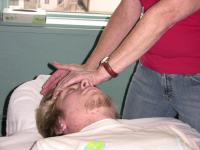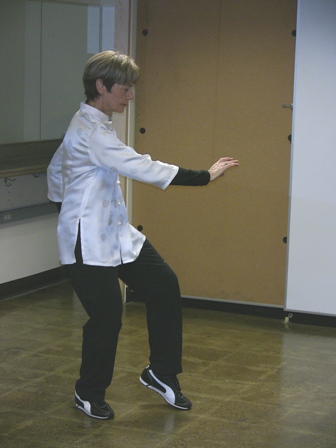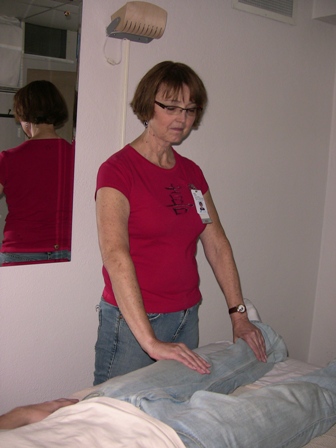Public embraces holistic healing, conventional medicine follows
 Kathy Kerber, a nurse, applies healing touch. Photo: K Stone
Kathy Kerber, a nurse, applies healing touch. Photo: K Stone
About 36 percent of American adults are using some form of complementary or alternative health therapy, according to a 2004 survey by the National Center for Complementary and Alternative Medicine (NCCAM). When megavitamins and prayers are included as healing assists, the participation rate rises to 62 percent.
Ruth Ann Plourde suddenly interrupted the workshop as her class was trying to recreate the graceful but agonizingly slow T’ai Chi forms she’d taught moments before. “How’s the monkey chatter now?” she asked. “Are you feeling in the present?”
No doubt about that. It took all one’s concentration to put the right foot out in front, lean into it, and simultaneously do the choo-choo move with the arms. No one was thinking about irritations at work, the price of gas, or picking up the kids. At the end of the class participants said they felt focused and relaxed.

Ruth Ann Plourde, an assistant professor in the Holistic Health Studies Program at the University of St. Catherine, demonstrates T'ai Chi at Restore, a holistic health conference held in Minneapolis. Photo: K Stone
An assistant professor of holistic health at the University of St. Catherine, Plourde teaches T’ai Chi and Qigong classes and brings the exercises into the workplace through her company, “Innergize.”
She was one of more than 30 holistic health teachers giving hour-long introductory workshops and presentations at “Restore,” a conference held recently at the Aveda Institute in Minneapolis attended by several hundred women and a handful of men.
Warren King, a licensed acupuncturist and specialist in auricular medicine (based on taking cues from the energy emanating from a patient’s ears to detect and treat illness) focused much of his talk on environmental toxins and how they affect our health. “You might be taking your neighbor’s drugs,” he offered, underlining the revelation that scientists have found traces of prescription drugs in drinking water tested around the country. King believes many common illnesses can be traced to arsenic in chicken, mercury fillings in our teeth, rocket fuel in tap water, and the prevalence of parasites, particularly among travelers to the tropics. Coupled with a diet of unprocessed and simple foods, “80 to 90 percent of the time herbs or homeopathic medicine can kill off” the toxins or parasites that are causing chronic fatigue, nausea or PMS, said King.
Several healing touch practitioners volunteered to give 15-minute sessions throughout the day, including Aimee Prasek, an organizer of the event and alum of the holistic health studies program at the University of St. Catherine. Healing touch is an energy therapy that uses gentle hand techniques, on or off the body, that are thought to open the patient’s energy field and get the energy moving to accelerate healing of the body, mind and spirit.

Kathy Kerber demonstrates "healing touch" at a holistic health conference. A nurse with a master's degree in holistic health studies, Kerber uses energy healing in her practice at Abbott Northwestern Hospital in Minneapolis. Photo: K Stone
While some people feel no sensation under healing touch, others describe a sensation of flowing energy, relaxation, feeling supported or nurtured, and they may sense images and colors. Some patients may feel an emotional release or have a sudden insight into their lives. And some might elicit an unexpected stomach gurgling or need to cough during an energy session. “That’s typical,” said Prasek. “Things are opening up and moving around.”
Patients and healthy individuals have been turning to alternative healing methods such as energy work, meditation and yoga for years, and in the case of chiropractic, for decades. Now conventional Western medicine is getting on board with what it calls “complementary and alternative medicine” or “CAM.” (The National Center for Complementary and Alternative Medicine defines CAM as "a group of diverse medical and health care systems, practices, and products that are not presently considered to be part of conventional medicine.") The NCCAM estimates that 36 percent of American adults are using some form of CAM. When megavitamin therapy and prayer specifically for health reasons are included, that number rises to 62 percent.
Conventional or not, most leading teaching hospitals and major universities in the United States now offer CAM training programs and despite tighter budgets, hospitals across the country are launching new holistic healing centers for patient care. Sponsors of Restore included the University of Minnesota, the Mayo Clinic, Abbott Northwestern, and the University of St. Catherine, among two dozen other CAM-focused organizations and businesses.
Brent Bauer, MD, director of the Mayo Clinic’s Complimentary and Integrative Medicine program, said “physicians are slowly coming around” to acknowledging the benefits of CAM. He highlighted key findings of published studies undertaken by the Centers for Disease Control and Prevention, the National Institutes of Health, Mayo Clinic, MD Anderson Cancer Center, and other giants in health care research that provide evidence that alternative health therapies like acupuncture, meditation and yoga help reduce pain, improve overall quality of life, and reduce stress. That’s significant since stress is accepted as a leading contributor to many diseases as well as premature aging.
Most traditional medicine practitioners are unwilling to say that CAM does more than reduce stress because it’s currently next to impossible to gather evidence, measure, or quantify changes that take place during alternative healing, especially those based on moving one’s energy field.
Taking the leap of experiencing a healing modality such as healing touch, Qigong or acupuncture requires an open mind, but not a leap of faith nor a turning away from conventional medicine. In fact, many nurses and a growing number of doctors are trained in CAM therapies and offer them in their practices. Almost everyone approaches their first energy healing session with some skepticism. We’ve been programmed that illnesses and injuries are treated with surgery and drugs. There’s been little advocacy of preventative health care beyond the fundamentals of eating a healthy diet and getting adequate exercise.
So now CAM is coming into the mainstream and conventional medicine is following the trend. Might we soon see national TV ads for FDA-approved natural herbs, 1-800 phone healings and meditations that will help you reach a state of non-thinking bliss alongside the ads for Cialis?
Related:



 del.icio.us
del.icio.us Digg
Digg












(Despite changing the setting my form keeps regressing and putting in a double "http." I'll try fixing it again but the best way to get links to work is to leave off the "http://)
How does auricular medicine pulse testing work and is it painful?
In your studies, you came across “a few dozen choices” for composites. Can you name one that does not leach BPA? What about denture plastic? Is there a compatibility test for that as well?
1) Cheap.
2) Modern healing cannot detect its cause, or has surrendered.
Not eveyone can afford the Cadillac of health care. The brain and the heart together are the greatest healing tools.
Post your comment